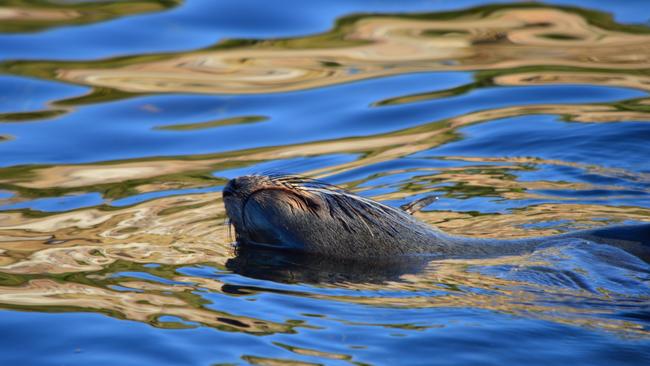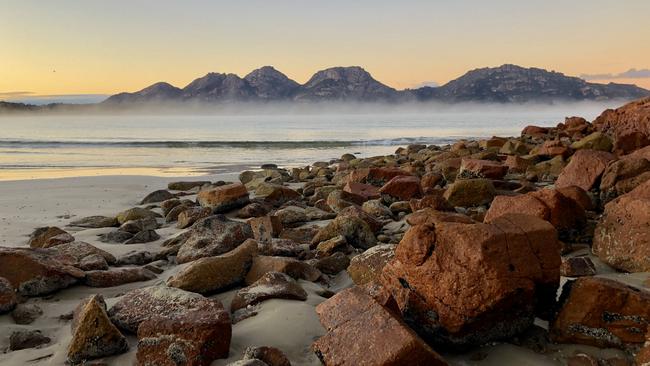It’s the shortest day of the year in Tassie and we are in the middle of a feeding frenzy. It’s a feast of sorts, but we are nowhere near the Hobart waterfront or Dark Mofo.
We are on a boat just outside Schouten Passage near the southern end of the Freycinet Peninsula and the air is filled with seabirds.
There’s a run on bait fish, and the birds and several seals are churning up the sparkling, choppy water. It’s a brilliant winter’s day; sunny and crisp, with just a light breeze.
TASMANIAN TOURISM’S HIDDEN GEMS
There are at least five species of albatross, plus Australasian gannets, crested terns and gulls soaring and diving. A smackerel of mackerel perhaps.
The display impresses our hosts Kerry Williams and Kim Bambrook, who run bespoke tours for Freycinet Charters aboard a 10m catamaran.
“It’s a real treat for us, too. We don’t often see so many different species of albatross,” says Kerry, an experienced skipper who has spent the past 35 years working in Tasmanian waters.

For a group of six of us it’s a highlight on our affordable three-hour trip booked on a whim that morning. It takes in majestic granite cliffs of Cape Degerando on the far southeast corner of the Freycinet Peninsula and the striking coastline on the northern end of Schouten Island.
We pull in midway down the peninsula to visit a small colony of Australian fur seals sheltering in the lee of Refuge Island.
There is a group of young pups floating on the surface with flippers out of the water. They look relaxed and contented in the sunshine, unfussed by our presence as they perform their seal yoga. Kim tells us they lift their flippers out of the water to cool them — a type of rudimentary airconditioning.

They twist and dive effortlessly, curiously taking in the boat. One pup nips at its companions, trying to start a playful game. It’s clear they are having fun.
Kerry and Kim have a passion for wildlife, and their vast knowledge of the coastline is clear in the casual commentary.
The boat easily accommodates our mix of two families, with a comfortable covered-in cabin to retreat into from the elements and an awning over the rear deck area. It’s a purpose-built vessel, modern and clean, with on-board tea and coffee and a small toilet if required.
As we head down the peninsula we pull close to the shore and they point out a huge sea eagle nest, at least 2m across, high in a tree. It is estimated to be at least 40 years old.
We see several of the magnificent birds on our trip, winging their way above the peninsula. One takes flight from its perch about 40m away launching into the air with a couple of sweeps of its powerful wings.

Lunch stop is Crocketts Beach — a beautiful sheltered inlet on the northern end of Schouten Island. We remove our shoes and paddle from the shallows on to the beach and picnic in the sun before strolling along the soft sand. It’s then back on board to take the leisurely cruise back to Coles Bay.
For some, Tasmania’s East Coast is a trip for the warmer months, a time to take in the long summer days. But the charms of this place, the gateway to Freycinet National Park, don’t end when the seasons turn cold.

To start, there are far fewer people. The previous day we parked in a near-deserted car park at the base of the Wineglass Bay walk and hiked to the top of Mt Amos. It can be a challenging walk, especially when the boot-polished granite becomes as slippery as ice if there’s a shower of rain. But the view from the top is spectacular — with sweeping vistas of Wineglass Bay and beyond.
Boulders defy gravity as they perch precariously on the rock face. It’s easy to imagine that a gust of wind might send one of the shed-sized rocks crashing down the slope.
Boulders of a different sort feature at Bluestone Bay, a careful drive along a 4WD-only road just before you get to Cape Tourville Lighthouse. There are lots of humps built into the gravel track, presumably to discourage regular sedans and motorhomes. After about 15 minutes of slow going, we arrive at a camping area above the beach. In one direction is Whitewater Wall, an impressive expanse of cliffs, popular with rock climbers. We watch as a barefooted climber on a ledge pulls in the slack for a companion below.

A little north is the sheltered bay itself. We sit on pillow-sized boulders, worn smooth by centuries of crashing waves, and warm ourselves as the afternoon sun sets behind the hills. It’s peaceful and deserted, but for tiny wrens hopping among the rocks and a seal lolling in the water just off shore.
There’s no one else around either on an early-morning run along Muirs Beach. If you fancied a nude solstice swim here, there’s no audience but a nervous sooty oyster catcher and tiny hooded plovers as they scurry along the waterline.
It’s cold, but it’s not just the icy air that will take your breath away. The first rays of the morning catch the top of the Hazard mountains and are reflected in the wet sand. A layer of sea mist rises from the water, softening the cool pink horizon.

This is the appeal of a winter trip up the coast. Just as in days gone by, you’re more than likely to enjoy hours where you have the place to yourself. No queues, no tourist buses, no background chatter.
It’s a chance to soak up the magic and tranquillity of one of Tasmania’s natural gems.
This was a completely self-funded trip and the author paid his own way.
GETTING THERE
Airlines fly daily into Hobart and Launceston. Coles Bay, on the Freycinet Peninsula, is about two hours driving time from both cities.
STAY
There are a range of short-stay accommodation options in Coles Bay. Try Forest Edgefor brilliant holiday retreat accommodating up to eight people. The home includes a large living area, freestanding wood heater, big modern kitchen, BBQ facilities and an expansive deck overlooking Freycinet National Park. From $240 a night.
DO
Freycinet Charters takes private family and small group bookings for up to 10 passengers. A three-hour Schouten Island cruise costs $750. Other package deals are available.

Add your comment to this story
To join the conversation, please log in. Don't have an account? Register
Join the conversation, you are commenting as Logout
Check out Airbnb’s latest: Where history meets slow travel bliss
Overlooking Australia’s oldest bridge in the historic village of Richmond, this convict-crafted accommodation offers a backstage pass to history – best enjoyed with a glass of wine in hand, writes Cas Garvey
Is this Bicheno’s dreamiest coastal outlook?
Perched on a sand dune overlooking the ocean, this East Coast retreat offers dazzling views, style and serenity. Add sun, wild swims and whale sightings – it’s clear Bicheno has never looked better